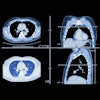Reconstructed CT data offers the first practical imaging method of assessing esophago-gastric adenocarcinoma response to chemotherapy as classified by the World Health Organization's histologic scale, Danish researchers reported at the European Congress of Radiology.
Dr. Hermann Helmberger presented the results of a four-year study to assess the diagnostic value of volumetric measurements for response evaluation to neoadjuvant chemotherapy in 83 patients with advanced adenocarcinoma of the esophago-gastric junction (AEG) and stomach.
While the WHO histological classifications measure tumor size volumetrically (in cubic centimeters), experience and available literature suggest that the standard imaging techniques -- including conventional CT, endoscopy, sonography or PET -- are ill suited to this type of measurement, Helmberger said.
"The focus of our study was to evaluate the CT data to correlate our response with quantitative and semi-quantitative results, for example from endoscopy or sonography, and to correlate these results with histopathology," he said.
The patients, all with advanced masses of the esophago-gastric junction and stomach, were scanned prior to therapy, after one cycle of chemotherapy, and again preoperatively following a second chemotherapy cycle. The researchers used a spiral CT protocol and 1000 ml of an oral negative contrast agent and 130 ml of injected contrast agent.
Volumetric measurements were performed on the resulting images, and secondary reconstructions were created on a commercially available Quantum workstation with new imaging software. Data presegmentation reduced storage requirements, and the software trimmed the normally time-consuming manual reconstruction process down to about 20-30 minutes per patient, Helmberger said. All of the patients underwent subsequent resection of the masses, providing histological correlation of the findings.
Chemo response was then evaluated using both conventional planimetry and 3-D reconstruction volumetry. The response was accurately gauged far more often with CT with volumetry (81%) than in CT with planimetry (55%) according to Helmberger.
"With response evaluation using volumetry, there's no invasiveness, it's reproducible, and you get real quantifying data," Helmberger said, "so we think this is a suitable imaging modality for quantitation of response."
By Eric Barnes
AuntMinnie.com staff writer
April 3, 2000
Let AuntMinnie.com know what you think about this story.
Copyright © 2000 AuntMinnie.com
















